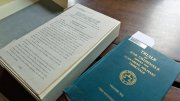1928 The first reading period at Harvard College has proven successful in bolstering student achievement. The Bulletin cites an increase in honor and satisfactory grades and a corresponding decrease in unsatisfactory marks as proof upperclassmen have the "capacity and interest to work independently."
1933 A significant number of Crimson articles and editorials suggest that the newly established Houses are "acquiring distinct individuality." The articles, written by House committee chairmen, are meant to influence freshmen.
1938 Excavation for the Littauer Center for Public Administration, which will stand on the former site of the Old Hemenway Gymnasium, is now complete and work on the cement foundation is underway.
1943 Presidents James Bryant Conant and Ada Louise Comstock of Harvard and Radcliffe jointly issue an agreement delegating to the Harvard Faculty of Arts and Sciences "complete responsibility for the program of instruction of students in Radcliffe College at both the graduate and undergraduate levels." Radcliffe in return will "pay to Harvard each year a lump sum for the instruction so provided." Tensions over the ambiguity of the original Harvard-Radcliffe relationship catalyzed the planning of the carefully worded agreement.
1953 "The name of Harvard was injected early into the hearings of the House Un-American Activities Committee," the editors report, as congressional leaders listened to "testimony about Communist activity at the University in the late thirties" from three former faculty members.
1958 With the masters of the eight existing Houses pitching in, shovels in hand, ground is broken for the College's newest living space--Quincy House.
1968 The library system is facing its greatest space crunch since Widener became full for the first time, 30 years earlier. The solution then called for the construction of Houghton, Lamont, and the New England Deposit Library.
1973 The Faculty of Arts and Sciences is considering modifications to the regular four-year A.B. experience, such as adding a work-study program if practical work in the field has a direct relationship with a particular academic discipline.
1983 A review of the College's five-year old Core Curriculum is underway. A background report notes that more than 1,500 members of the class of 1982 took Core courses, even though they were not required to.
1988 Harvard-Radcliffe Alumni/ Alumnae Against Apartheid again solicit signatures to nominate candidates to the Board of Overseers, with the aim of "seek[ing] full divestment of all securities the University holds in companies doing business with South Africa."





